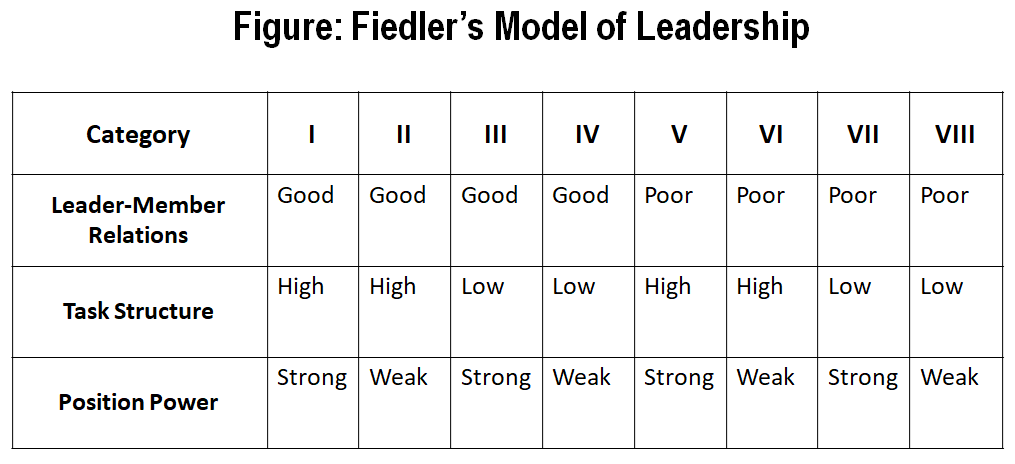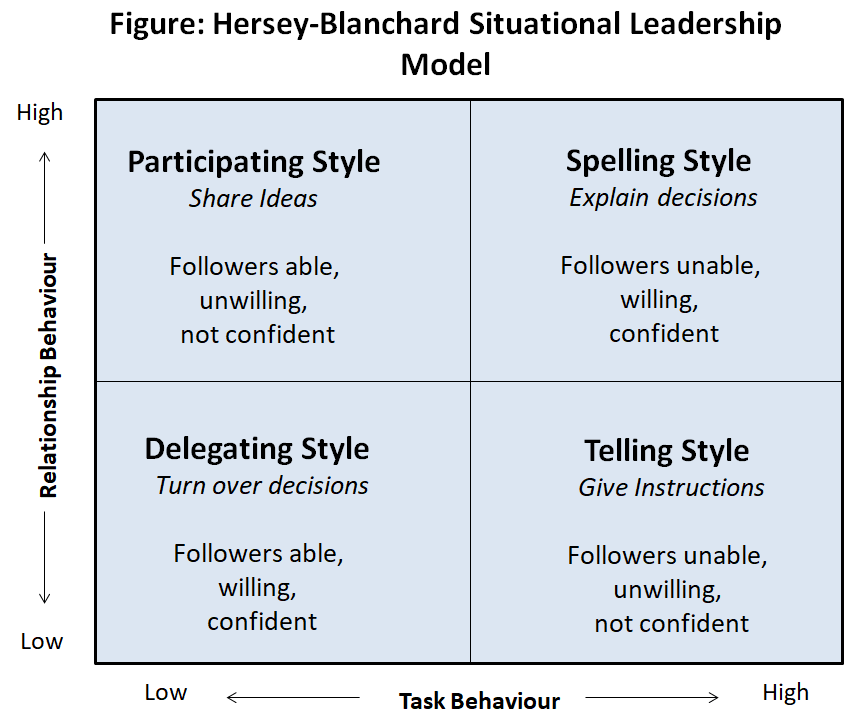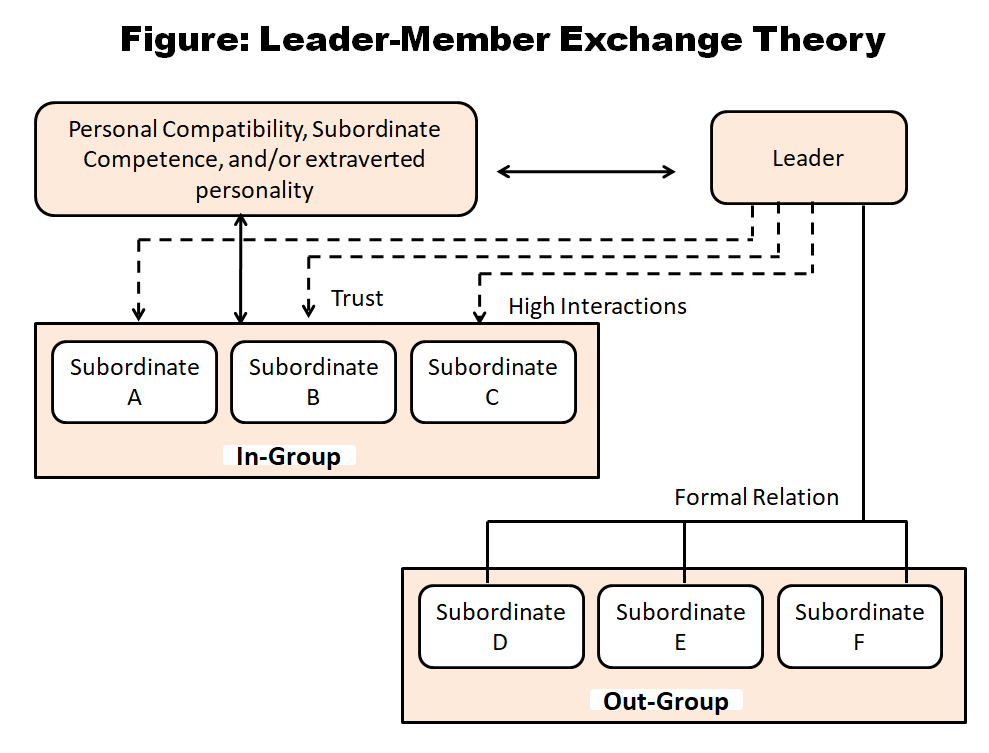Table of Contents:-
- Contingency theory of leadership
- Fiedler’s model,
- Hersey and Blanchard’s Situational theory,
- Leader-member exchange theory,
- Path-Goal theory, and
- Leader-Participation model,
Contingency theory of leadership
During the late 1960s, researchers Blanchard, Fielder and Chemers, House and Filley, and Vroom, found out that neither trait theory nor behavioural theory of leadership could fit with every situation, and suggested that situational characteristics should also be considered in leadership study. Contingency theory of leadership advocates that leadership is strongly affected by the situation from which a leader emerges and in which he works. It is based on the assumptions that, an interaction exists between a group and its leader and that people tend to follow the person (known as leader) who is capable of fulfilling their aspirations. He determines the needs of the situation and then acts accordingly. Thus, the leader is a means of achieving the goals of the group and its members
Sometimes, the success of a leader does not solely depend on the leader’s qualities, traits, and behaviour. The context in which a leader demonstrates their skills, traits, and behaviour is important, as the same approach may not be suitable for different situations. Thus, the effectiveness of leadership is also contingent on various situations. Numerous research studies, when investigating the reasons for inconsistent results with the same leadership styles in different conditions, have focused on situational variables. This theory conceives leadership as a dynamic interaction involving several situational variables, such as the leader, the followers, the task situation, the environment, and more.
Some notable studies on the contingency theory of leadership that have gained wide recognition include the following:
- Fiedler’s model,
- Hersey and Blanchard’s Situational theory,
- Leader-member exchange theory,
- Path-Goal theory, and
- Leader-Participation model,
The contingency theory of leadership is discussed below.
Fiedler Model
In 1967 Fred Fiedler developed a comprehensive model for the contingency theory of leadership he was the first person to introduce this concept. The basic premise behind this theory is that the effective performance of an organization or a group of people within an organization depends significantly on the style adopted by a leader and the degree to which a situation affords control to the leader.
To assess the leadership style, Fiedler developed the “Least-Preferred Coworker” (LPC) scale, where leaders were asked to express their preference for the employee they least preferred to work with. If the least preferred co-worker was described favourably, the response was classified as ‘relationship-oriented,’ and if rated unfavourably, the leader was considered ‘production-oriented.’ However, in contrast, the responses from this study did not provide a clear-cut picture, as some responses fell within the mid-range scores.
Consequently, it became challenging to categorize a leader as either relationship-oriented or production-oriented, as the scoring was neither high nor low. Fiedler’s model thus drew attention to a new dimension in leadership studies. The study suggested that if a situation requires a task-oriented leader, and the person in that leadership position is relationship-oriented, either the situation has to be modified, or the leader replaced, to achieve optimal effectiveness (Robbins, Judge, & Sanghi, 2007).
Situational Factors
Based on the results obtained, Fiedler identified three situational factors: leader-member relations, task structure, and position power, which determine leadership effectiveness. A brief discussion of these situational factors is as follows:
i) Leader-Member Relations: The degree of confidence, trust, and respect that members have in their leader.
ii) Task Structure: The degree to which job assignments are structured or unstructured.
iii) Position Power: The degree of influence a leader possesses over power variables, such as firing, hiring, discipline, promotions, and salary increases.
Fiedler’s model evaluates leadership effectiveness based on the degree of existence of the aforementioned situational factors. The degree varies from good to poor in leader-member relations, strong to weak in position power and high to low in task structure.
According to Fiedler, leadership is considered to have more control over organizational situations when leader-member relations are good, task assignments are highly structured, and there is stronger positional power. Conversely, situations in an organization are deemed unfavourable if the respect that members have for leaders is poor, task assignments are unstructured, and position power is weak.
Based on the situational factors, the Fiedler model identifies eight different kinds of situations or categories in which a leader can identify their position.

Fiedler states that a task-oriented leader performs better in situations that are very favourable or very unfavourable to them (Category I, II, III, VII, or VIII situations). Relationship-oriented leaders, on the other hand, excel in moderately favourable situations (categories IV through VI). In recent years, Fiedler has condensed these eight situations into three. He asserts that task-oriented leaders perform better in situations of high and low control, while relationship-oriented leaders perform best in situations of moderate control.
Drawbacks of the Fiedler model
However, one of the major drawbacks of the Fiedler model is that it assumes the style adopted by a particular leader is fixed. The theory posits that a leader can only follow a specific style in any given situation and suggests changing the leader to fit a situation. For example, the assumption is that if a situation in an organization is highly unfavourable, and the organization is led by a relationship-oriented leader, the organization’s performance could be improved by replacing the leader with one who is task-oriented. Another alternative suggested is to change the situation to suit the leader. This involves restructuring tasks or adjusting power positions, with the expectation that the leader can then bring the situation under control.
While Fiedler’s model offers useful propositions, the practical application of the theory is highly questionable. In practice, it is generally difficult to assess the quality of leader-member relations, the level of task structure, and the extent of a leader’s position power (Robbins, Judge, & Sanghi, 2007).
Cognitive Resource Theory
In the early 1990s, Fiedler and his associate Joe Garcia reconceptualized the original Fiedler model as Cognitive Resource Theory. This model focuses on the role of stress management as a form of situational unfavorableness and examines how a leader’s intelligence and experience influence their stress reaction. The underlying assumption of this theory is that stress is the enemy of rationality, and a leader cannot think logically and analytically if they are under a high level of stress.
According to this proposition, the significance of a leader’s intelligence and experience for effectiveness varies under low and high-stress situations. Fiedler and Garcia assert that a leader’s intellectual ability correlates positively with performance under low stress but negatively under high stress. Conversely, a leader’s experience exhibits a negative correlation with performance under low stress but a positive correlation under high stress. Therefore, as per Fiedler and Garcia, the stress level in a situation determines whether an individual’s intelligence or experience will have an impact on leadership performance.
Hersey and Blanchard’s Situational Theory
One of the path-breaking models that were developed in the contingency theory of leadership studies is that of the Situational Leadership Theory (SLT), which was put forward by Paul Hersey and Ken Blanchard. The focus of this theory is laid on the followers and the readiness that followers show to accept leadership. The basic assumption behind this theory is that it is the followers who accept or reject a leader and thus, the effectiveness of a leader also depends on their followers.
Thus, regardless of what a leader does, the effectiveness of leadership depends upon the actions of the followers. By readiness, Hersey and Blanchard mean the extent to which people have the ability and willingness to accomplish a specific task set by the leader. In analyzing the leader-follower relationship, the Situational Leadership Theory likens the relationship to that of a parent and a child.
Situational Theory Analysis
According to Hersey and Blanchard, four types of leadership behaviour vary from highly directive to highly laissez-faire, which again depends upon the ability and willingness of followers to perform a given task.
According to SLT, if a follower is unable and unwilling to do a task, the leader needs to give clear and specific directions; if followers are unable and willing, the leader needs to display high task orientation to compensate for the follower’s‟ lack of ability and high relationship orientation to get the followers to „buy into‟ the leader‟s desire; If followers are able but unwilling, the leader needs to use a participative and supportive style; and if the employee is both able and willing, the leader doesn’t need to do much.

This contingency theory of leadership thus gives a new dimension to the study of leadership, and the aspects that appeal to this theory are the importance given to the followers and the capacity of the leader to compensate for the ability and motivational limitations in their followers. However, despite the wide recognition and popularity that this theory has gained, it is said to have internal ambiguities and inconsistencies.
Leader-Member Exchange Theory
Another new dimension was added to Theories of Leadership with the proposition of the Leader-Member Exchange (LMX) Theory. The assumption behind this theory is that a leader cannot use a fairly homogeneous style with all of the people in their work unit, and a leader acts differently with different people, tending to have their ‘in-group.’
Thus, according to this theory, a leader maintains a special relationship with a small group of their followers due to time pressures. The people in the ‘in-group’ tend to receive more attention, have the trust of the leader, enjoy special privileges, and even have informal interactions with the leader. On the contrary, followers in the ‘out-group’ spend less time with the leaders, and have limited access to rewards and privileges, and the leader-follower relationship is based on formal authority interactions.

The people in the ‘in-group’ are chosen based on personal compatibility with the leader, competence, attitude, and personality exhibited by the followers. Though the ‘in-group’ is chosen by the leaders, it is the follower’s characteristics that drive the leader’s categorizing decision. However, inherent dangers exist in being part of the inner circle. Sometimes, the fortune of the inner circle tends to rise or fall along with the leader.
In general, followers in the ‘in-group’ status will have higher performance ratings, lower turnover intentions, greater satisfaction with their superior, and higher overall satisfaction than the ‘out-group.’ Sometimes, the fortune of the inner circle tends to rise or fall along with the leader. In general, followers in the ‘in-group’ status will have higher performance ratings, lower turnover intentions, greater satisfaction with their superior, and higher overall satisfaction than the ‘out-group.’
Path-Goal Theory
The Path-Goal Theory was developed by Martin Evans and Robert House in 1970-71, drawing inspiration from the concepts of initiating structure and consideration from the Ohio State Studies, as well as the Expectancy Theory of Motivation. The foundation of the Path-Goal theory lies in the idea that effective leaders clarify the path to assist their followers in progressing from their current position toward achieving work goals.
In this process, the leader removes roadblocks that hinder the followers’ path, making their journey smoother. Thus, the essence of the path-goal theory is that it is the leader’s responsibility to provide followers with the information, support, and other resources necessary for them to achieve their goals (Robbins, Judge, & Sanghi, 2007).
Path-Goal Theory Analysis
This contingency theory of leadership identifies four types of leadership behaviour:
- Directive leader,
- Supportive leader,
- Participative leader, and
- Achievement-oriented leader.
Unlike Fiedler, who assumes the leader to follow a fixed leadership style, the theory put forward by House assumes the leader to be a flexible person who can display different kinds of behaviours based on a given situation.
The four types of leadership behaviour identified by Robert House are given as follows:
1. Directive Leader: A directive leader clarifies the roles expected of the followers, schedules the work to be done, and provides the necessary direction or guidance on how to accomplish tasks.
2. Supportive Leader: A supportive leader behaves in a friendly manner with the followers, and the main concern of the leader is placed on the needs of the followers rather than on accomplishing the tasks.
3. Participative Leader: A participative leader involves the followers in the consultation process and also gathers suggestions or views from the followers before making a decision.
4. Achievement-Oriented Leader: An achievement-oriented leader sets challenging goals for the followers and expects them to perform at their highest level.
The above-mentioned leadership styles under the path-goal theory are contingent upon two factors: characteristics of employees and environmental factors. Environmental factors include aspects such as task structure, formal authority system, workgroup, etc., while employee characteristics include aspects like locus of control, experience, perceived ability, etc.
Leader-Participation Model
The Leader-Participation Model was developed by Phillip Yetton and Victor Vroom in 1973. This theory is also referred to by different names such as the Decision-Participation Model and Normative Model. It is called normative because it provides a sequential set of rules that should be followed in determining the form and amount of participation in decision-making, as determined by different types of situations.
According to this model, three sets of variables affect the performance of the leader in terms of their capacity as a decision-maker, which include:
- Quality of the decision;
- Degree of acceptance of the decision by subordinates; and
- Time required to make the decision.
Thus, based on the identified variables, Vroom and Yetton defined five different kinds of decision making procedures, representing a continuum from authoritarian approaches (AI, AII), consultative approaches (CI, CII), and a group-based approach (G2), as follows:
- A1: The Leader takes known information and then decides alone.
- A2: The leader gathers information from followers and then decides alone.
- C1: The leader shares the problem with followers individually, listens to ideas, and then decides alone.
- C2: The leader shares the problem with followers as a group, listens to ideas, and then decides alone.
- G2: The leader shares the problem with followers as a group and then seeks and accepts consensus agreement.
The Evolving Landscape of Leadership
The contingency theory of leadership that analyzes situational context brings to light the challenging role that a leader has to play, especially women leaders. Their lives are a mix of a complex fabric of personal, professional, and community involvements and responsibilities. This complexity becomes even more pronounced in contingent situations. Since women leaders function in more than one context (family, workplace, community), managing different contexts simultaneously remains a major challenge for women leaders (Klenke, 2011).
While the theories that have been discussed above are conventional theories, which have unique inputs to offer even to this day, it has also given way to the new set of leadership theories viz. Transactional and Transformative theories of leadership, Visionary Leadership theory, etc. While the conventional theories laid their focus on the traits, qualities, and behaviour exhibited by a leader, the modern theories make a shift in the way leaders are perceived. From the position of an omnipotent hero and saviours of organizations, the leaders are now looked at as normal people, whose decisions can lead both to success or failure of an organization. Thus modern theories give more importance to the leader-follower equation. While the traditional theories are leader-centric, the new theories have a follower-centric perspective.
You May Also Like:-
Transactional Analysis in Organisational Behaviour
Techniques of Organisational Development
Need for Organisational Development
Characteristics of Organizational Development
Factors Affecting Organisational Culture
Causes of Conflict in an Organisation
Types of Conflict in an Organisation
Group Decision Making Techniques
Factors affecting group behaviour
Challenges and Opportunities of Organisational Behaviour
Importance of Organisational Behaviour
Scope of Organisational Behaviour
behavioural theory of leadership
Factors Influencing Perception
Theories of Leadership in organisational behaviour
